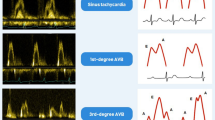Abstract
Background
The atrial myocardial sleeve of the pulmonary vein is the most common source of arrhythmogenic triggers in atrial fibrillation. The present study was designed to study the atrial muscle sleeve in detail, to help in planning and execution of “trigger mapping and ablation” procedure, used for treating resistant atrial fibrillation.
Methods
A longitudinal tissue section was taken along the length of each pulmonary vein including the posterior wall of the left atrium, from 15 normal human formalin fixed hearts. The histological and micro-morphometric details of the atrial muscle sleeve were studied.
Results
A muscle sleeve composed of cardiac muscle was found in each pulmonary vein, situated between adventitia and media, and separated from media by clearly defined connective tissue. The fiber arrangement was non uniform and angular changes in the fiber direction were frequent. Autonomic ganglia were found in the adventitia. The sleeve was tapering distally but reduction was not circumferentially uniform, minimum thickness was more for right (~ 0.2 mm) than for left veins (0.1 mm). The mean atrial sleeve length was 6.3 mm; the left veins had longer sleeve then right while left inferior veins had the maximum mean length.
Conclusion
The trigger mapping should be done for 2 cm on pulmonary veins to fully cover the atrial muscle sleeve. The gradual tapering of the atrial sleeve indicates that the maximum intensity ablative lesions would be needed at the veno-atrial junction while the ablation power should be reduced distally. Distal triggers on right veins would need more ablation then on the left veins.




Similar content being viewed by others
Abbreviations
- ANS:
-
Autonomic nervous system
- H&E:
-
Haematoxylin and eosin
- RSPV:
-
Right superior pulmonary vein
- RIPV:
-
Right inferior pulmonary vein
- LSPV:
-
Left superior pulmonary vein
- LIPV:
-
Left inferior pulmonary vein
- PV:
-
Pulmonary vein
References
Anderson RH, Spicer DE, Moris A (2016) Of tracts, rings, nodes, cusps, sinuses, and arrhythmias—a comment on Szili-Torok et al.’s paper entitled “the ‘dead-end tract’ and its role in arrhythmogenesis”. J Cardiovasc Dev Dis 3(2):17
Armour JA et al (1997) Gross and microscopic anatomy of the human intrinsic cardiac nervous system. Anat Rec 247(2):289–298
Calkins H, Hindricks G, Cappato R, Kim YH, Saad EB, Aguinaga L et al (2017) HRS/EHRA/ECAS/APHRS/SOLAECE expert consensus statement on catheter and surgical ablation of atrial fibrillation. Heart Rhythm 14(10):e275–e444
Gelsomino S, Corradi D, Lorusso R, PariseO CS, Macchi E, MeirM La (2012) Anatomical basis of minimally invasive epicardial ablation of atrial fibrillation. Eur J Cardiothorac Surg 43(4):673–682
Gupta T, Cheema N, Randhawa A, Sahni D (2020) Translational anatomy of the left atrium and esophagus as relevant to the pulmonary vein antral isolation for atrial fibrillation. Surg Radiol Anat 42(4):367–376
Haïssaguerre M, Shah D, Jaïs P, Hocini M, Yamane T, Deisenhofer I, Garrigue S, Clémenty J (2000) Mapping-guided ablation of pulmonary veins to cure atrial fibrillation. Am J Cardiol 86(9A):9K–19K. https://doi.org/10.1016/S0002-9149(00)01186-3
Hassink RJ, Aretz HT, Ruskin J, Keane D (2003) Morphology of atrial myocardium in human pulmonary veins: a postmortem analysis in patients with and without atrial fibrillation. J Am Coll Cardiol 42(6):1108–1114
Ho SY, Cabrera JA, Tran VH, Farre J, Anderson RH, Sanchez-Quintana D (2001) Architecture of the pulmonary veins: relevance to radiofrequency ablation. Heart 86:265–270
Kholová I, Kautzner J (2003) Anatomic characteristics of extensions of atrial myocardium into the pulmonary veins in subjects with and without atrial fibrillation. Pacing Clin Electrophysiol 26(6):1348–1355
Kholová I, Niessen HWM, Kautzner J (2003) Expression of Leu-7 in myocardial sleeves around human pulmonary veins. Cardiovasc Pathol 1:263–266
Kirklin/Barratt-Boyes (2013) cardiac surgery: morphology, diagnostic criteria, natural history, techniques, results, and indications. In: Kouchoukos NT, Blackstone EH, Hanley FL, Kirklin JK (eds) 4th edn, vol 1. Elsevier, Philadelphia
Larsen WJ (1997) Development of heart. In: Stapf V (ed) Strauss M. Human embryology, Churchill Livingstone p, pp 151–188
Moubarak JB, Rozwadowski JV, Strzalka CT, Buck WR, Tan WS, Kish GF, Kisiel T, Fronc HC, Maloney JD (2000) Pulmonary veins-left atrial junction: anatomic and histological study. Pacing Clin Electrophysiol 23(11):1836–1838
Po SS, Nakagawa H, Jackman WM (2009) Localization of left atrial ganglionated plexi in patients with atrial fibrillation. J Cardiovasc Electrophysiol 20(10):1186–1189
Polaczek S, Szaro P, Baranska I, Burakowska B, Ciszek B (2019) Morphology and morphometry of pulmonary veins and the left atrium in multi-slice computed tomography. Surg Radiol Anat 41:721–730
Roux N, Havet E, Mertl P (2004) The myocardial sleeves of the pulmonary veins: potential implications for atrial fibrillation. Surg Radiol Anat 26:285–289
Saito T, Waki K, Becker AE (2000) Left atrial myocardial extension onto pulmonary veins in humans: anatomic observations relevant for atrial arrhythmias. J Cardiovasc Electrophysiol 11:888–894
Sánchez-Quintana D, López-Mínguez JR, Macías Y, Cabrera JA, Saremi F (2014) Left atrial anatomy relevant to catheter ablation. Cardiol Res Pract 289720:17. https://doi.org/10.1155/2014/289720
Santangeli P, Marchlinski FE (2017) Techniques for the provocation, localization, and ablation of non-pulmonary vein triggers for atrial fibrillation. Heart Rhythm 14(7):1087–1096
Tagawa M, Higuchi K, Chinushi M et al (2001) Myocardium extending from the left atrium onto the pulmonary veins. Pacing Clin Electrophysiol 24:1459–1463
Tan AY, Li H, Wachsmann-Hogiu S, Chen LS, Chen P, Fishbein MC (2006) Autonomic innervation and segmental muscular disconnections at the human pulmonary vein-atrial junction. JACC 48(1):132–143
Acknowledgements
We would like to acknowledge all the body donors for their valuable contribution.
Funding
None.
Author information
Authors and Affiliations
Corresponding author
Ethics declarations
Conflict of interest
The authors declare that they have no conflict of interest.
Ethical approval
The experiments comply with the current laws of the country in which they were performed. The project was approved by the Institute Ethical Committee.
Additional information
Publisher's Note
Springer Nature remains neutral with regard to jurisdictional claims in published maps and institutional affiliations.
Rights and permissions
About this article
Cite this article
Gupta, T., Randhawa, A. & Sahni, D. Histological evaluation of atrial muscle sleeve of pulmonary veins as relevant to trigger mapping and ablation. Surg Radiol Anat 42, 1271–1277 (2020). https://doi.org/10.1007/s00276-020-02473-z
Received:
Accepted:
Published:
Issue Date:
DOI: https://doi.org/10.1007/s00276-020-02473-z




